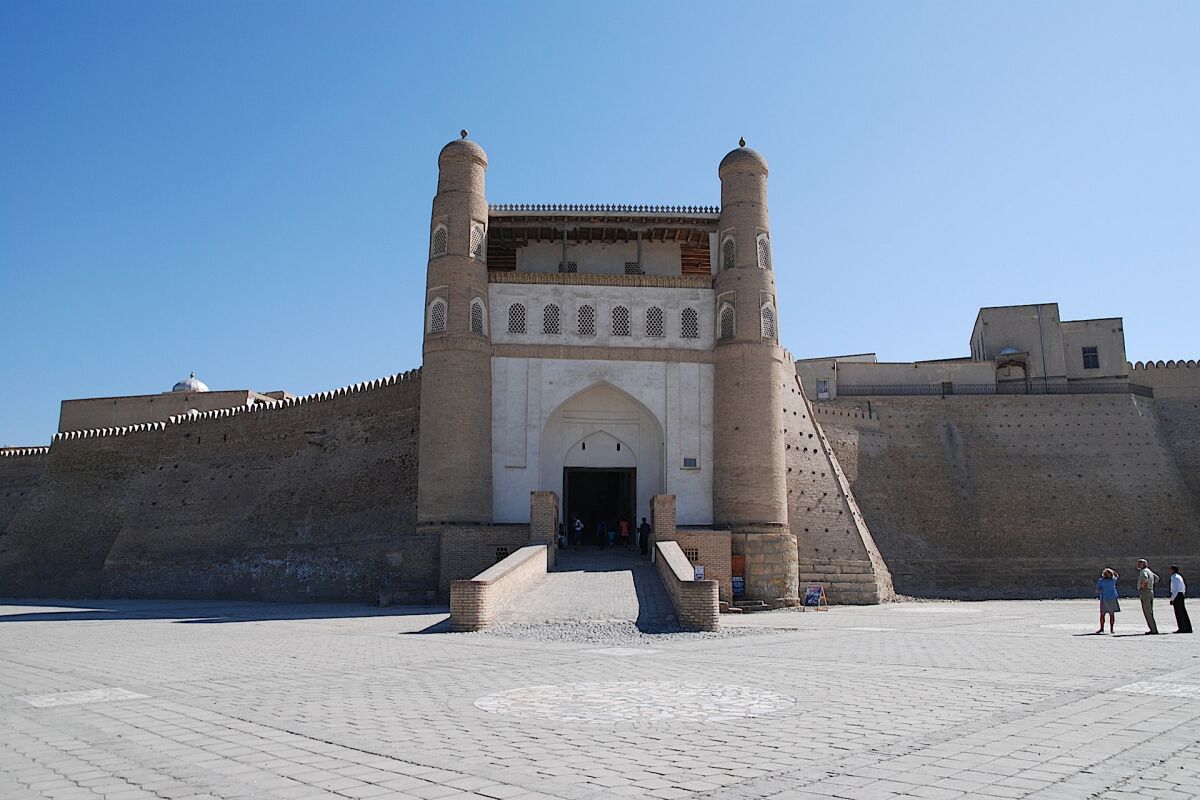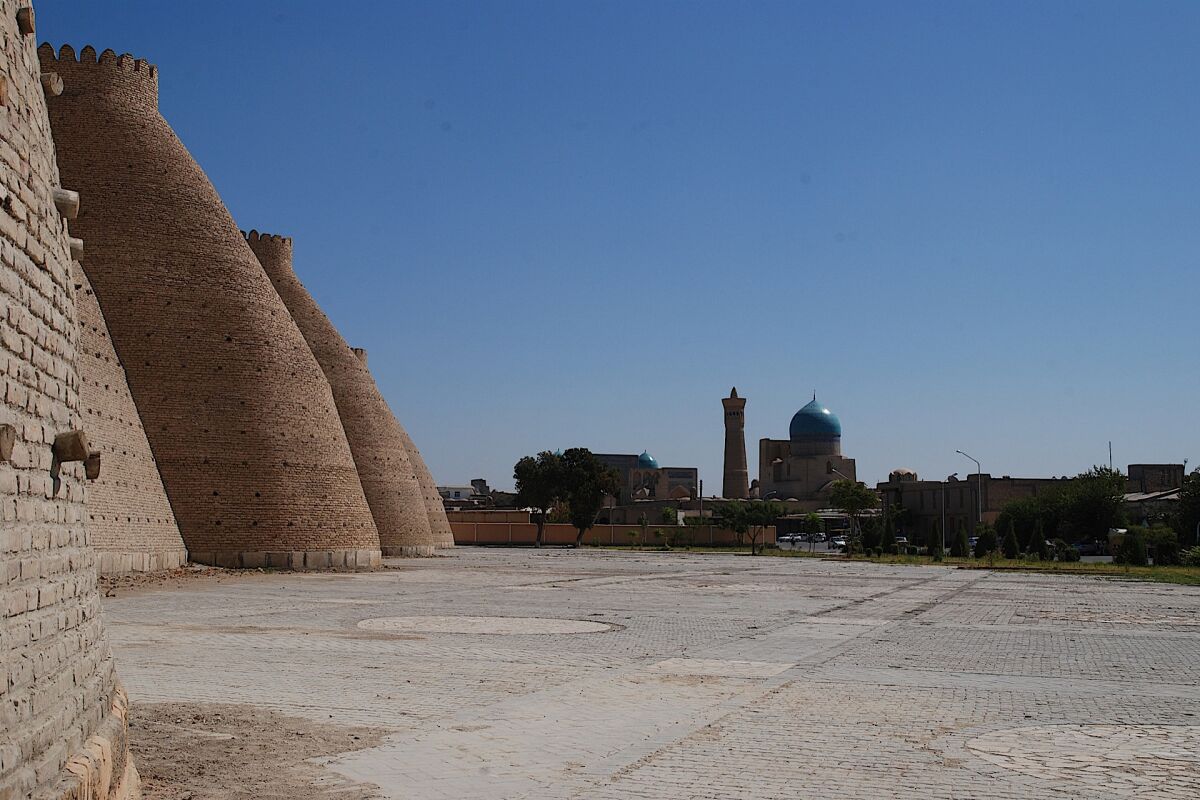Bukhara - Citadel Ark

The Citadel Ark in Bukhara – a bastion of history
The monumental Ark Citadel rises in the center of Bukhara, a bulwark of the last emirs and an impressive testimony to the city’s millennia-old history. Archaeological remains prove that the first settlements existed here at the beginning of our era – their foundations lie far deeper than today’s surface.
High brick walls with jagged battlements surround an imposing hill on which the origins of Bukhara manifested themselves over two thousand years ago. The citadel of Ark was not just a fortress, but the political, economic and religious center of the city.
The legends and historical roots
Over the centuries, the height of Ark gradually increased as new buildings were erected on the ruins of the old ones. Legend has it that the tomb of the mythical Siyavush, the legendary founder of the city, is located here.
In the 7th century AD, the citadel played a decisive role under the rule of Queen Hutak Khatun. She defended Bukhara with wisdom and diplomatic skill against the advancing Arab armies. The medieval historian Narshakhi reported these events with the words: “Allah instilled fear in the hearts of the infidels and they left the city without taking up the fight.”
The citadel in the Middle Ages and its significance
Hidden deep in the archaeological layers of Ark lie the remains of former palaces and fortifications. The emirs of Bukhara resided here during the Middle Ages. Right next to the main entrance gate hung a whip (Kamchin) as an unmistakable symbol of emiral power.
Only a few of the citadel’s once mighty buildings remain today. Grain was processed into flour day and night on the upper terrace of Nagorakhan. A remarkable historical feature was the trophy clock, which was made in the 19th century by the captured Italian clockmaker Orlando. It struck every hour and served as an acoustic sign for the passage of time. Five times a day, the azanchis (prayer callers) climbed the bell tower to call out the prayer.
During the Ramadan celebrations, the Feast of Sacrifice (Kurban) and other important occasions, an orchestra played in a special ritual. The musicians change their curtains and robes in symbolic colors – first in bright yellow, then in fiery red and finally in deep black.
Registan – the square in front of the citadel
The square in front of the citadel, the Registan, was the beating heart of public life in Bukhara. Important ceremonies, markets, religious gatherings and executions took place here. The Registan was not only the central place of the city, but also the religious center.
The construction of the Ark Citadel required the immense labor of thousands of slaves who created an artificial hill under the scorching sun and without modern tools. To comprehend the enormity of this construction achievement, you have to go back to a time when even simple means of transportation such as the arava (a traditional cart) were not used.
A symbol of power – and of transience
The Ark Citadel was a symbol of unshakeable power that the emirs wanted to raise above Registan Square. But this impression was deceptive. Time and again, the Ark was destroyed, plundered and rebuilt – a fate shared by many mighty fortresses in history.
Although the exact age of the Ark cannot be determined with certainty, it is certain that it served as the seat of the ruler of a vast and densely populated country at least one and a half thousand years ago.
For many centuries, the citadel remained the center of emirate power. Not only the emir himself lived here, but also his most important advisors, the grand vizier, military leaders and a large number of officials and servants. Ark was not just a fortress, but the vibrant administrative and governmental center of Bukhara.
Today, Ark Citadel still towers over the city – an impressive relic of the past and an important cultural heritage of Uzbekistan.
The conquest by Genghis Khan
In 1220, Bukhara fell victim to the unstoppable warriors of Genghis Khan. The city’s inhabitants sought refuge in the citadel of Ark, but the Mongol troops stormed the building, defeated the defenders, plundered the treasures and left behind a devastated fortress. This attack marked a deep turning point in the history of Bukhara and the citadel.
Uprisings and symbol of tyranny
Over the centuries, there have been repeated uprisings in Bukhara, often linked to the citadel of Ark. It became a symbol of cruel rule, especially when an uprising against a failed currency reform broke out in 1708. Angry citizens threw cobblestones at the gates of the fortress – an expression of their desperation and resistance to the rulers.
Center of science and culture
Despite its role as a center of power, the Ark Citadel was also a center of knowledge. Some of the greatest scholars, poets and philosophers of the Middle Ages lived and worked here. Names such as Rudaki, Firdousi, Abu Ali ibn Sina (Avicenna), Farabi and later Omar Khayyam are inextricably linked with the heyday of Bukhara’s culture. The citadel was therefore not only a place of rule, but also a center of science and poetry.
Architecture and structure
The Ark Citadel is a large, above-ground complex with an irregular rectangular layout. It stretches from west to east and has a slightly cut south-eastern corner.
- Length of the walls: 789.60 meters
- Total area: 3.96 hectares
- Height above Registan Square: 16 to 20 meters
The citadel is located in the western part of the modern city of Bukhara. Its main entrance is characterized by two mighty pillar towers connected by a gallery. Above them is a room with terraces overlooking the surrounding area.
Access to the inside of the citadel is via the main gate, also known as the “Tahkul”. This is a long ramp, flanked by massive stone railings, which is about 20 meters long. The corridor leads to the Jami Mosque and other important buildings within the fortress.
Symbol of rule: the Emir’s whip
A large leather whip was once attached to one of the walls of Ark Citadel – a clear sign of the emir’s power. Inside the fortress there was a long, dark corridor, along which there were storage rooms for water and sand as well as gloomy prison cells. Tradition tells of cruel torture methods used by the emir to subdue his subjects.
The Childukhtaron Mosque and its dark legend
Within the eastern half of the citadel is an important archaeological monument: the Childukhtaron Mosque. Legend has it that forty young women were cruelly tortured here and thrown into a well. This story gives Ark Citadel a dark but mysterious aura.
A unique panoramic view
From the heights of Ark Citadel, you can enjoy a breathtaking panorama over the historic part of Bukhara. Restorers describe the fortress as a “textbook for master builders”, as it has been subject to various architectural influences over the centuries.
Restoration work and conservation
 Extensive restoration work is currently underway to preserve this monumental building for future generations. In particular, the walls on the Registan Square side and numerous interior rooms have already been carefully restored. These measures ensure that Ark Citadel remains an important cultural heritage site and continues to captivate visitors from all over the world.
Extensive restoration work is currently underway to preserve this monumental building for future generations. In particular, the walls on the Registan Square side and numerous interior rooms have already been carefully restored. These measures ensure that Ark Citadel remains an important cultural heritage site and continues to captivate visitors from all over the world.
Ark Citadel is not only an architectural masterpiece, but also a place where power, culture, science and history come together in a unique way.
